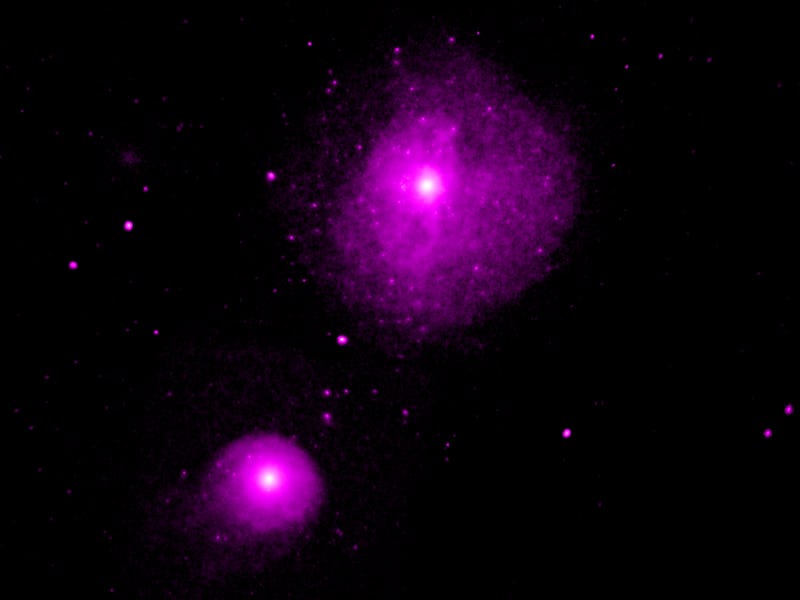Ancient, massive stars may help solve a mystery about our Sun
"They can even shape entire galaxies."

Around 13 billion years ago, the first stars were born. These massive ancient stars produced chemical elements — hydrogen and helium — and released these elements out into the cosmos. This cycle birthed the second generation of stars.
Most massive stars exist in pairs, bound by a common orbit. Scientists have long assumed these stellar companions were born next to one another. However, new research suggests that the stars start off further apart and come closer together over the course of a million years.
Understanding the evolution of these massive stars helps us peek back into the early years of the universe's formation, and the creation of stars like our Sun.
The new findings are detailed in a study published Wednesday in Astronomy and Astrophysics Letters.
Lead author María Ramírez-Tannus, a postdoctoral fellow at the Max Planck Institute for Astronomy in Heidelberg, Germany, was struck by how these massive stars are always found in these close pairs — interlocked in an orbital dance around a common center.
"The fact that massive stars are in close binaries affects their evolution," Ramírez-Tannus tells Inverse. "They emit a lot of energy and a lot of momentum that they transmit to their surroundings, they can even shape entire galaxies."
These massive stars also produce heavy chemical elements which become the building blocks for new stars, planets, and life itself, she adds. All of the elements that make up celestial objects in the universe, as well as the carbon, nitrogen, and oxygen atoms in our bodies, were originally created in stars.
However, scientists did not understand how these massive binary star systems evolved over time due to a lack of observations of their earlier stages.
Digging into the details — In order to figure out how these pairs came to be, the study team observed young stars in star-forming regions, particularly in the Omega Nebula. This region is known for having a few massive stars at its core.
Using the Very Large Telescope (VLT) of the European Southern Observatory (ESO), located in the Chilean Atacama Desert, the team measured the speed of the stars and determined their brightness and surface temperature.
An illustration that shows the different scenarios that may have formed the massive star binary systems.
By combining the new measurements with previous data collected on the stars, they were able to measure their velocity dispersion — the statistical measure of the radial velocities of stars orbiting in the same direction.
The stars were found to have originally formed on large orbits and, around a million years or so ago, developed into these close binary systems.
"When we talk about stellar evolution, we didn't know how these binary stars came together," Ramírez-Tannus says. "We would always assume that these massive binary stars are born close to each other, but they actually need a couple of million years to come together."
Why do these stars come together? — More research is needed to know for sure, but the study team hypothesizes this process may be caused by one of two possible scenarios.
The first scenario has to do with how the stars first came into existence. Stars are born from dense clouds of gas and dust. Over time, the rotation of these clouds causes them to flatten into a disc-like structure with the star forming at its center. If the massive stars are born in pairs, then the friction between their orbits and the disc would cause the orbits to shrink over time — and for their orbiting speeds to increase.
The second scenario suggests the binary pair were actually born with a third, lower-mass stellar companion. The gravitational force of the smaller star may force the larger ones into an elliptical orbit that shrinks over time. Meanwhile, the small companion eventually gets thrown out of the system.
The researchers plan to conduct further observations of the star forming region in order to look at more of these binary star systems, and observe their evolution over time.
"These massive stars produce heavier elements, most of the elements we are made of," Ramírez-Tannus says. "The oxygen we breathe, the iron in our blood, all of these elements are created in these massive stars and then released to their surroundings."
"Understanding how these stars evolve, how they interact with their companions, helps us in understanding when and how exactly these elements are released in the interstellar medium."
Abstract: The majority of massive stars (> 8 M⊙) in OB associations are found in close binary systems. Nonetheless, the formation mechanism of these close massive binaries is not understood yet. Using literature data, we measured the radial-velocity dispersion (σ1D) as a proxy for the close binary fraction in ten OB associations in the Galaxy and the Large Magellanic Cloud, spanning an age range from 1 to 6 Myr. We find a positive trend of this dispersion with the cluster’s age, which is consistent with binary hardening. Assuming a universal binary fraction of fbin = 0.7, we converted the σ1D behavior to an evolution of the minimum orbital period Pcutoff from ∼9.5 years at 1 Myr to ∼1.4 days for the oldest clusters in our sample at ∼6 Myr. Our results suggest that binaries are formed at larger separations, and they harden in around 1 to 2 Myr to produce the period distribution observed in few million-year-old OB binaries. Such an inward migration may either be driven by an interaction with a remnant accretion disk or with other young stellar objects present in the system. Our findings constitute the first empirical evidence in favor of migration as a scenario for the formation of massive close binaries.